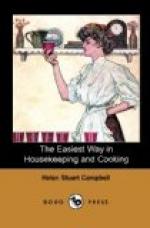LEGUMINOUS SEEDS are of more importance, embracing as they do the whole tribe of beans, pease, and lentils. Twice as much nitrogen is found in beans as in wheat; and they rank so near to animal food, that by the addition of a little fat they practically can take its place. Bacon and beans have thus been associated for centuries, and New England owes to Assyria the model for the present Boston bean-pot. In the best table-bean, either Lima or the butter-bean, will be found in a hundred parts, thirty of nitrogen, fifty-six of starch, one and a half of cellulose, two of fatty matter, three and a half of saline, and eight and a half of water. The proportion of nitrogen is less in pease, but about the same in lentils. The chestnut also comes under this head, and is largely eaten in Spain and Italy, either boiled, or dried and ground into flour.
TUBERS and ROOTS follow, and of these the Potato leads the van. Low as you may have noticed their standing on the food-table to be, they are the most economical and valuable of foods, combining as well with others, and as little cloying to the palate, as bread itself. Each pound of potatoes contains seven hundred and seventy grains of carbon, and twenty-four grains of nitrogen; each pound of wheat-flour, two thousand grains of carbon, and one hundred and twenty of nitrogen. But the average cost of the pound of potatoes is but one cent; that of the pound of wheat, four. It is obtainable at all seasons, and thus invaluable as a permanent store, though best in the winter. Spring, the germinating season, diminishes its nutritive value. New potatoes are less nutritious than older ones, and in cooking, if slightly underdone, are said to satisfy the appetite better; this being the reason why the laboring classes prefer them, as they say, “with a bone in them.”
In a hundred parts are found but two of nitrogen, eighteen of starch, three of sugar, two-tenths of fat, seven-tenths of saline matter, and seventy-five parts of water. The Sweet-potato, Yam, and Artichoke are all of the same character. Other Tubers, the Turnip, Beet, Carrot, and Parsnip, are in ordinary use. The turnip is nine-tenths water, but possesses some valuable qualities. The beet, though also largely water, has also a good deal of sugar, and is excellent food. Carrots and parsnips are much alike in composition. Carrots are generally rejected as food, but properly cooked are very appetizing, their greatest use, however, being in soups and stews.
HERBACEOUS ARTICLES follow; and, though we are not accustomed to consider Cabbage as an herb, it began existence as cole-wort, a shrub or herb on the south coast of England. Cultivation has developed it into a firm round head; and as a vegetable, abounding as it does in nitrogen, it ranks next to beans as a food. Cauliflower is a very delicate and highly prized form of cabbage, but cabbage itself can be so cooked as to strongly resemble it.




